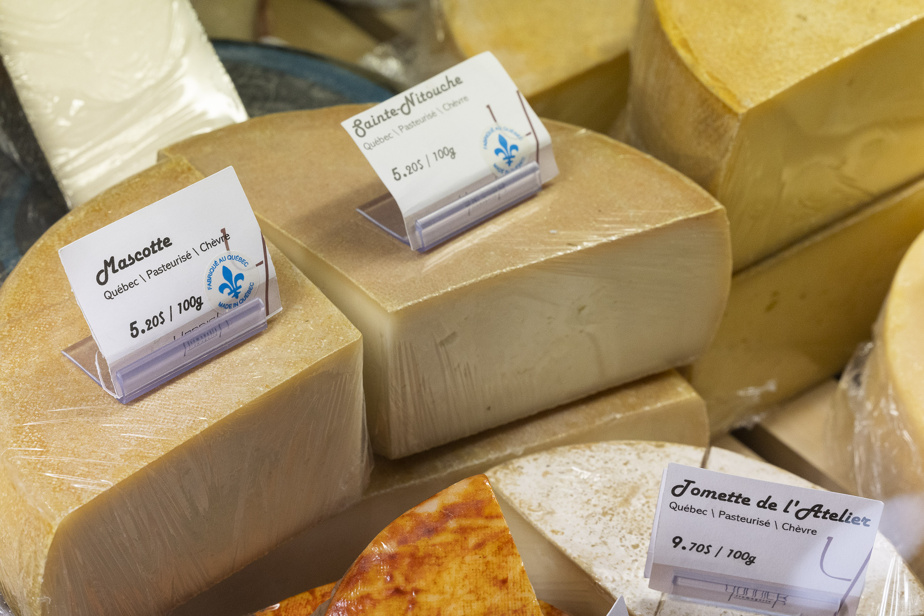Trade agreements that “hurt”. Declining consumption. And inflation which forces people to make choices. These are all reasons which pushed the Quebec Milk Producers (PLQ) to highlight local cheeses by developing a classification system based on taste tags, a bit like wine at home. SAQ.
“We react with different tactics. We know that trade agreements have hurt. We do not yet have all the impact data. But we gave up a lot of market share, admitted Julie Gélinas, marketing director for the PLQ, during an interview with The Press. If we want to help consumers find their way around better, it is obviously to try to make them even more aware (of the importance of) selecting products from us. »
In force since 2017, the Comprehensive Economic and Trade Agreement between Canada and the European Union (CETA), has allowed the entry of “17.7 million kilograms of cheese into the Canadian dairy products market, through allocation of tariff quotas (TRQs)”, we can read on the website of the Dairy Processors Association of Canada. These tariff quotas make it possible to totally or partially eliminate customs duties. Results: once arrived at the supermarket and in the cheese shops, foreign products can be sold at lower prices, directly competing with local cheeses, the producers of La Belle Province have repeatedly denounced.
To add to the difficulties, in one year, Quebecers’ appetite for cheese, regardless of its origin, has decreased slightly. Consumption fell by 1.3% – according to NielsenIQ –, which adds to the difficulties of the industry which must “react”, according to Mme Gelinas.
In order to promote local products, the PLQ have therefore implemented a cheese categorization system using three profiles: flavor, intensity, texture. “This beautiful variety is interesting, but it is also complex. Nearly 31% of consumers say they have difficulty finding their way to make new discoveries,” says Julie Gélinas, in light of data obtained during a recent survey.
On the fromagesdici.com website, for example, Clos des Roches Réserve from Fromagerie des Grondines is described as being a firm, fruity paste with powerful intensity. For the moment, nearly 400 cheeses, out of a total of 1079, have been classified on the site. Retailers and cheesemakers will also receive kits allowing them to classify products according to the tablets. If they are not required to comply, they have given an “enthusiastic welcome” to the project, assures Mme Gelinas. And some producers are considering adding them directly to their packaging.
In addition to allowing consumers to taste new products, the taste tags, with their description, will give them the possibility of substituting a European cheese that they may be used to buying for a Quebec cheese having the same characteristics. same characteristics. At least that’s the bet milk producers are making.
A strategy praised by Yannick Achim, owner of five Yannick Fromagerie stores. According to him, this classification will actually help “value the product”. “The taste patch follows the evolution of the consumer. It is a way of expressing the aromatic qualities of a product. I think it gives even more value to Quebec cheeses and the consumer is there,” he observes.
“From that moment on, we will see essentially the same evolution that we found in the world of wines. The consumer will be interested in understanding why a particular flavor is found in a cheese. Why is it nutty? Why do we have a high intensity? »
Although he also notices a slight decrease in the quantities purchased by his customers, Mr. Achim believes that they are nevertheless making “better choices”. “The consumer will be more sensitive to what they buy, to the quantities. But on a qualitative level, he no longer makes compromises. I think he will move towards quality, even if it means having a little less. »
Cheese… some numbers
- Number of Quebec cheeses: 1079 (listed on the Fromages d’ici website)
- Consumption: 8.4 kilos per person in 2022 in Quebec (Quebecers are the largest consumers in the country)
- Proportion of milk used for cheese processing: 43% of milk production
Source: Quebec Milk Producers
